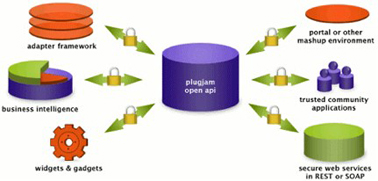Bringing Student Web "Stuff" to Campus Enterprise Systems
In a Starbucks in Cambridge, MA, I talked with Stuart Sim, CTO of CommonNeed (
www.commonneed.com). I knew Stuart from his days at Sun Microsystems, so was curious about his new startup, CommonNeed, which is two years old. CommonNeed is providing technology to interface Web 2.0 with existing campus-based systems such as the ERP, LMS, SIS or an assessment management system.
This company, therefore, is taking on a problem set that is giving headaches to higher education: How can an institution incorporate Web 2.0 learning opportunities for students, and evidence of learning from those opportunities, into existing campus technologies and processes? How do we "socialize" learning? What artifacts can students collect, how can campus IT provide the usual identity management and security layers for these artifacts, and how do faculty members judge this much wider range of student content in relation to the learning goals of the course?
These questions are important for higher education because Web 2.0 draws students into interaction, cooperation, identity creation, building archives, mashup or synthesis, social judgment, manipulation of multimedia objects, and so on. Such activities are almost all done as literate activities, that is, using a secondary code for communication--not speaking, the primary code, but writing, the secondary code. In other words, literacy training--along with other kinds of cognitive and social development--is going on "out there" without anyone having to assign the training. It's time to consider a formal use for these informal student development activities.
The questions above are also important because Web 2.0 technologies, sites, spaces, and simulations, are setting the standard for high-quality technology. On the Web, we may find a 2008 Prius while on campus we offer 1982 Dodges, so to speak. We want our students to drive a 1982 Dodge for serious work and we ignore the fact that they actually are out there in their brand-new Prius.
Many faculty members, to be sure, are out driving the Prius themselves. They have figured out how to, for example, introduce a new Web 2.0 site each week to their students, and how they'll work together with students on ways to use the site in their course.
But, does the work at the Web 2.0 site just stay "out there"? What if you want to import a photo collection from Flickr into the course management system, or information from sites posted at Delicious? Or include some video from YouTube in the LMS?
The interface between Web 2.0 and existing campus systems, including the SIS, the ERP, the LMS, and the ePortfolio assessment system, and others, is still, in large part, unexplored country. CommonNeed's PlugJam offers help.
In a tour of PlugJam (
www.plugjam.com) on the Web, the main definition is: "PlugJam is a solution for schools, colleges, and universities looking to bridge the gap between existing campus-based tools and Web 2.0 services, allowing students to use their favorite social networking environment or Web Service to access their campus-based resources."
So CommonNeed's Plugjam offers secure ways to move data back and forth between enterprise data systems and Web 2.0 sites and keep the data linked to the campus identity of the student (Graphic courtesy CommonNeed; see
www.plugjam.com):

Initiatives by other organizations tackle related but different pieces of the overall puzzle. For example, the Open Knowledge Initiative (OKI) with its Open Service Interface Definitions addresses root interfaces, assessment, authentication, authorization, course management, dictionary, filing, grading, hierarchy, ID, logging, repository, scheduling, shared, SQL, user messaging, and workflow. Those definitions are intended to improve the ability of different applications to talk to each other. And still other initiatives like Common Cartridge from IMS Global Learning, or SCORM, or the Learning Tools Interoperability Specification (LTI) all provide various other pieces.
Plugjam is providing a process, a set of tools working together, for using Web 2.0 technologies as extensions of campus-based systems. Plugjam can be virtualized on your campus (hosted by another party) or it can be installed.
We know that the Web is the new platform, the new cultural venue for commerce and cultural interaction. Higher education institutions have thrived for years as relatively autonomous organizations that imported academic content in the form of professors and books. Now, in the new model, these institutions instead become a highly energized and influential hub in the broader cultural knowledge creation process. Technology arrays like Plugjam will help drive this new model.
About the Author
Trent Batson is the president and CEO of AAEEBL (http://www.aaeebl.org), serving on behalf of the global electronic portfolio community. He was a tenured English professor before moving to information technology administration in the mid-1980s. Batson has been among the leaders in the field of educational technology for 25 years, the last 10 as an electronic portfolio expert and leader. He has worked at 7 universities but is now full-time president and CEO of AAEEBL. Batson’s ePortfolio: http://trentbatsoneportfolio.wordpress.com/ E-mail: [email protected]